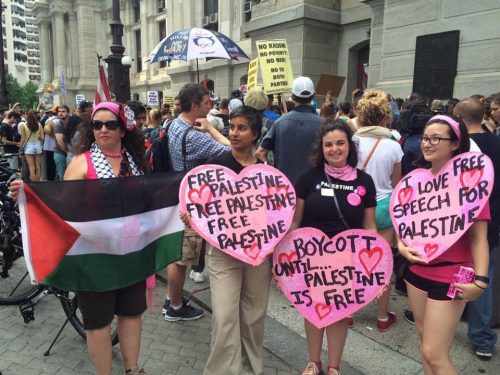
The Democratic National Convention (DNC) can most accurately be summed up as a conglomerate of protests. This wasn’t simply a coming-together of Democratic delegates casting their pledged vote. This was a rallying point for many groups to come together and express their displeasure, and often rage, at a system they have grown frustrated with.
Two points in Philadelphia became hot spots for protest: inside the Wells Fargo Convention Center itself and just outside the gated area of the convention. The inside protests manifested in small and large ways. Delegates could be seen holding signs in a gesture of dissent: “No TPP [Trans Pacific Partnership],” “Free Palestine” and “Liar” were common. Other, larger efforts occurred, such as the mass walk out by Bernie Sanders delegates, the illumination of state sections (Oregon and California) with cell phones when the convention sought to silence their sections by turning off the lights on them and strong chants such as “No More War,” which were combated with white noise machines to cancel out these voices of dissent, which might carry over through mainstream media airing.
Who were these people protesting inside the DNC? These were delegates. These were Bernie delegates. Yet, Hillary delegates conjured up retaliatory strategies, and each day, they became more strategic. If a protester or infiltrator (a non-delegate protester who happened to come into possession and use a delegate’s credentials to enter the DNC) happened to banner drop, hold a sign or chant, the Hillary delegates and security officials were quick to surround the individual and cover up their message in mass.
As perhaps a reflection of the corrupt practices already in place by the Clinton team, day three was rumored to be greeted by paid “seat fillers” (individuals who were paid $50 to seat in a vacant Bernie delegate’s seat. These individuals, posing as Hillary delegates, reserved rows of seats nearest to the front in an effort to minimalize disruption by Bernie delegates when speakers, especially Clinton, spoke live.
While watching mainstream media the previous days, a viewer could easily hear and see the disruption that was occurring among the delegates. As the days proceeded, however, the convention organizers became savvy to the tactics and increased censorship. These tactics and strategies were a slight reflection on what was going on outside of the convention.
Outside the convention gates, numerous groups organized to highlight their issue of concern. Black Lives Matter, Palestinian human rights, Democracy Spring, Antifa [anti-fascists], Food Not Bombs, CodePink and thousands of concerned people spent days marching, sitting in, documenting, speaking, sharing ideas and loudly voicing their dissent at the status quo. These protests manifested as rallies, marches, meetings, panels, speakers, sit-ins and blockades.
While there were obvious similarities in reasons why these protesters came together — and similarities in their goals — what was perhaps most obvious was the diversity of tactics used. In this manner, we can reflect on the outside protests as a divided and fragmented effort, in a similar way we can view the protesting inside.
Once again, the protesters outside could be divided into two camps: one that stressed a “nonviolent” approach based on a general understanding of Gandhi and MLK and another that embraced a diversity of aggressive tactics including flag-burning and cop-blocking.
While both camps of protesters seemed committed to their tactics, criticism of each other’s tactics was a piercing blow. Just as one might cringe, or perhaps delight, in watching a group of Clinton delegates swarm a single Bernie delegate with a protest sign, one could feel the drop in solidarity when a large group of hugging and singing protestors adamantly chanted “We’re not with them!” when protesters burned a flag or threw water balloons at police. In fact, this splitting was so severe that groups of protesters, largely from Democracy Spring, physically removed themselves repeatedly from the vicinity of any other group of protesters whose tactics they considered to not fall under their definition of nonviolence.
While the Democratic National Convention sought to systematically direct our nation into a goal-focused new year, the result could easily be described as a lump of chaotic dissent. From corrupt processes to criminal politicians, the DNC was met with bold resistance. With the help of alternative media and citizen journalists and the increasing participation of delegates as protesters, our two-party conventions are slowly seeing their dismantling as third parties are quickly becoming included in the political discourse and as the light more brightly shines through the holes in democracy. — Jennefer Harper
Jennefer Harper (left) and CodePink at the DNC